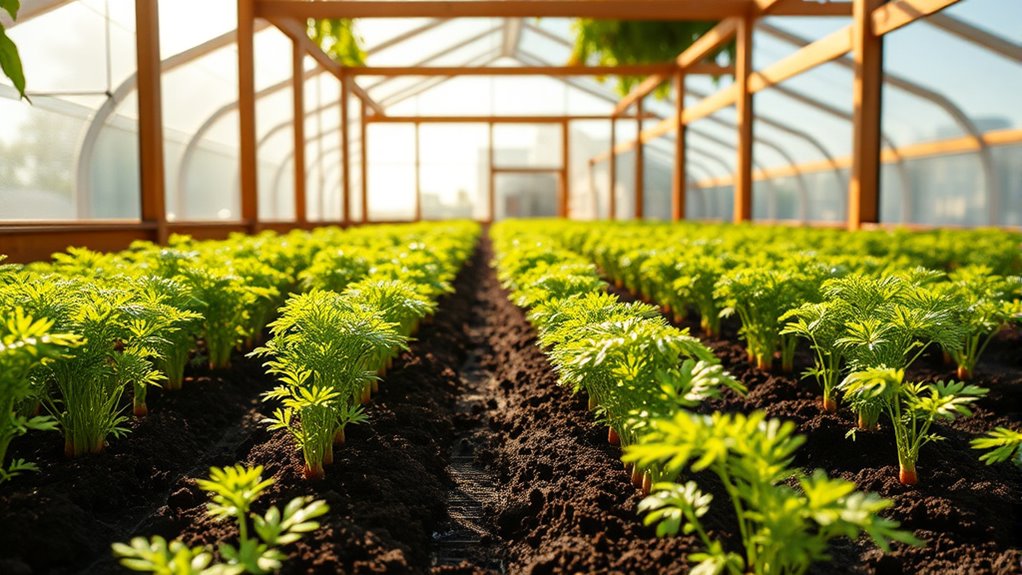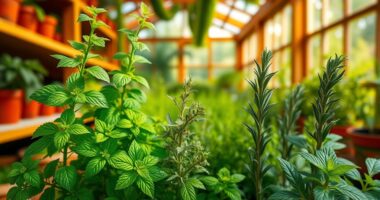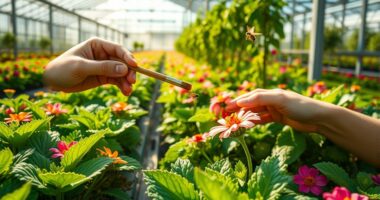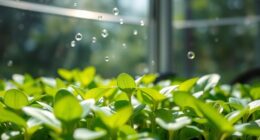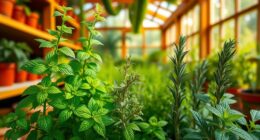To grow carrots in a greenhouse, start with well-drained, loamy soil and maintain temperatures between 55°F and 65°F. Choose seeds suited for your climate and space them ½ inch apart, sowing them ½ inch deep. Keep the soil consistently moist, aiming for one inch of water weekly, and fertilize every 3 to 4 weeks. With good care, you’ll see a healthy crop. There’s more you can explore for a successful harvest ahead!
Key Takeaways
- Ensure soil is light, loose, and well-drained with a pH of 6.0 to 6.8 for optimal carrot growth.
- Sow seeds ½ inch deep and ½ inch apart in moist, sandy soil for successful germination.
- Maintain greenhouse temperatures between 55°F and 65°F, and provide at least six hours of direct sunlight daily.
- Water consistently, aiming for one inch of water weekly, to prevent seed rot and promote healthy growth.
- Fertilize every 3 to 4 weeks with a balanced fertilizer, avoiding high nitrogen and manure to prevent poor root development.
Choosing the Right Environment for Carrots
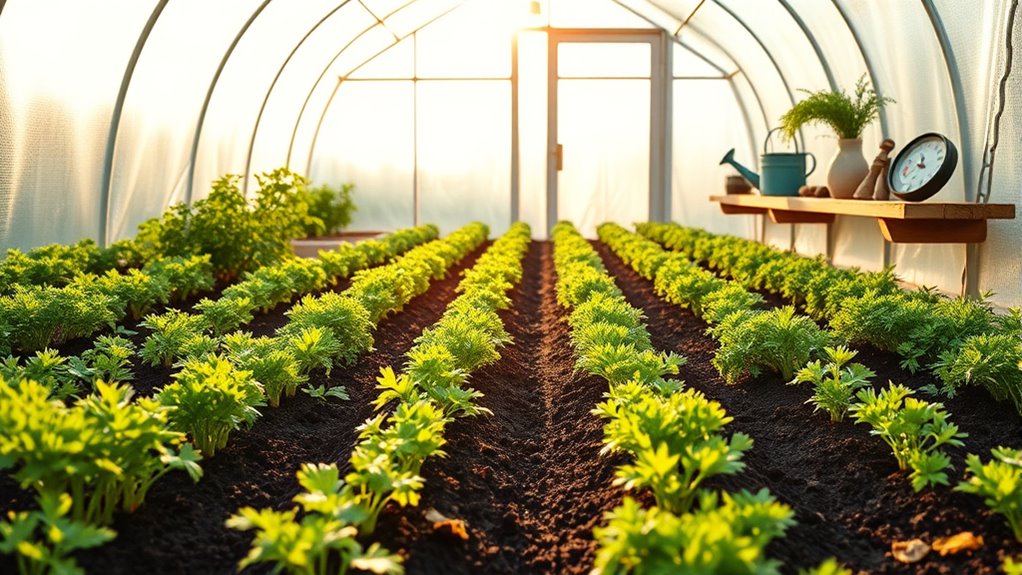
When growing carrots, choosing the right environment is crucial for success. Aim for temperatures between 55°F and 65°F, as this range allows your carrots to thrive.
During germination, ensure the soil temperature stays between 40°F and 85°F. Carrots can tolerate light frost, making spring and fall planting ideal.
Be careful with high temperatures, as they can cause your carrots to bolt and turn woody. For best results, provide full sun with at least 6 hours of direct light, but be mindful of excessive heat in summer.
If you’re using a greenhouse, balance light and temperature to create a favorable atmosphere for your carrot crop. Following these guidelines will set you up for a successful harvest!
Preparing the Soil for Carrot Growth
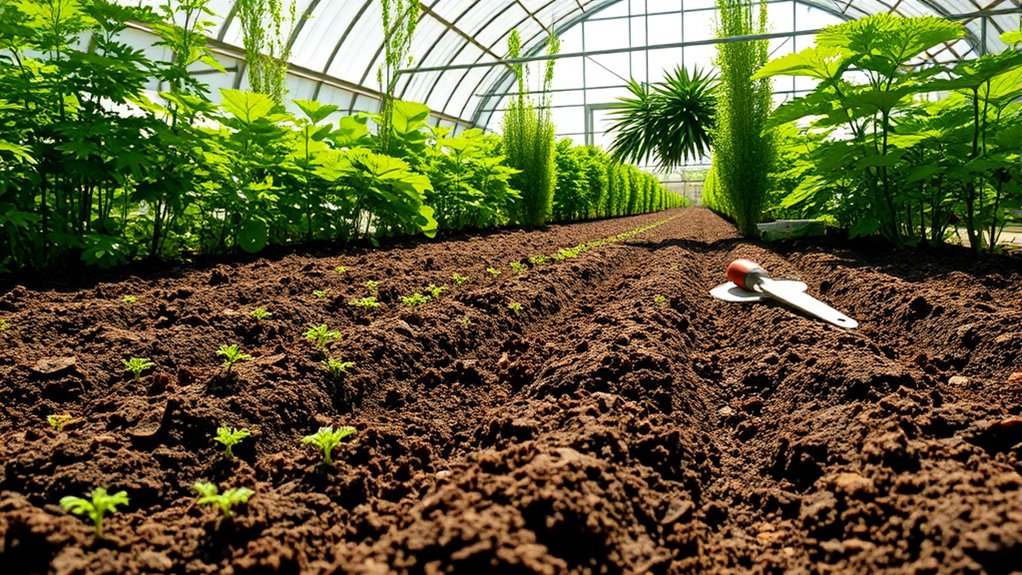
After establishing the right environment for your carrots, it’s time to focus on preparing the soil for optimal growth.
Carrots thrive in light, loose, and loamy soil, so avoid heavy clay or stony types that can hinder root development. Ensure your soil is well-drained to prevent waterlogging and root rot. Aim for a slightly acidic pH between 6.0 and 6.8.
Carrots flourish in light, loamy soil with good drainage and a slightly acidic pH of 6.0 to 6.8.
Tilling the soil deeply, ideally to 18 inches, helps create an ideal structure. Clear away debris and stones, and break up any lumps to promote aeration.
Apply a small amount of balanced fertilizer about a week before sowing, but keep organic matter out until the following year to avoid forked roots. Consistent moisture is key for germination and growth.
Selecting the Right Seeds for Your Greenhouse
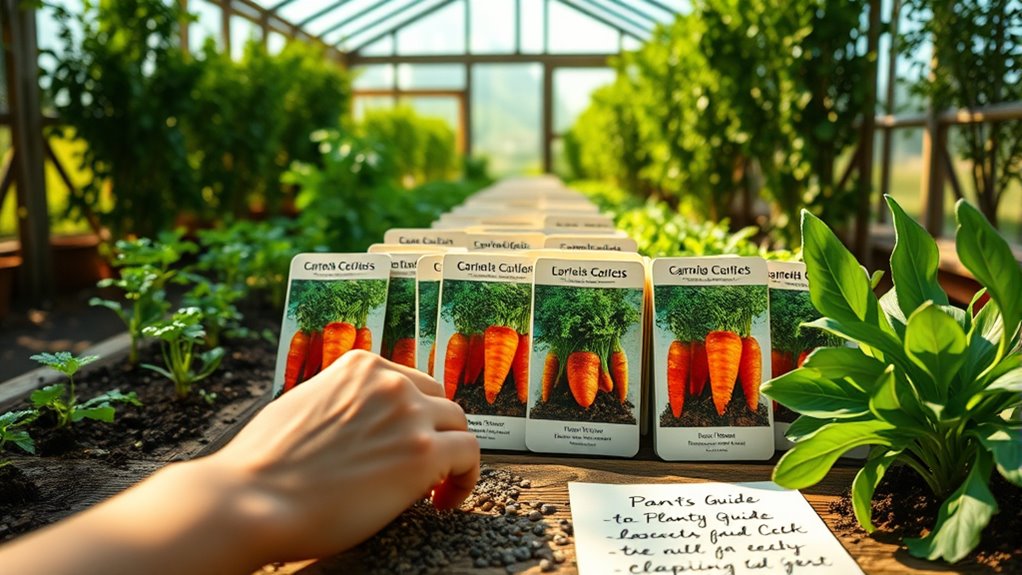
Choosing the right seeds for your greenhouse is crucial for a successful carrot harvest, as different varieties can yield varying results based on your specific conditions.
Start by considering heirloom versus hybrid seeds; heirlooms are open-pollinated, while hybrids are bred for specific traits. Look for seeds that suit your climate and have disease resistance.
Popular varieties include Nantes for their sweetness, Imperator for commercial production, and Parisian heirloom for container gardening.
Pay attention to root characteristics, like shape and size, to meet your culinary needs.
Finally, store your seeds properly to maintain their viability. With careful selection, you’ll set the stage for a bountiful carrot crop in your greenhouse.
Sowing Carrot Seeds in Optimal Conditions
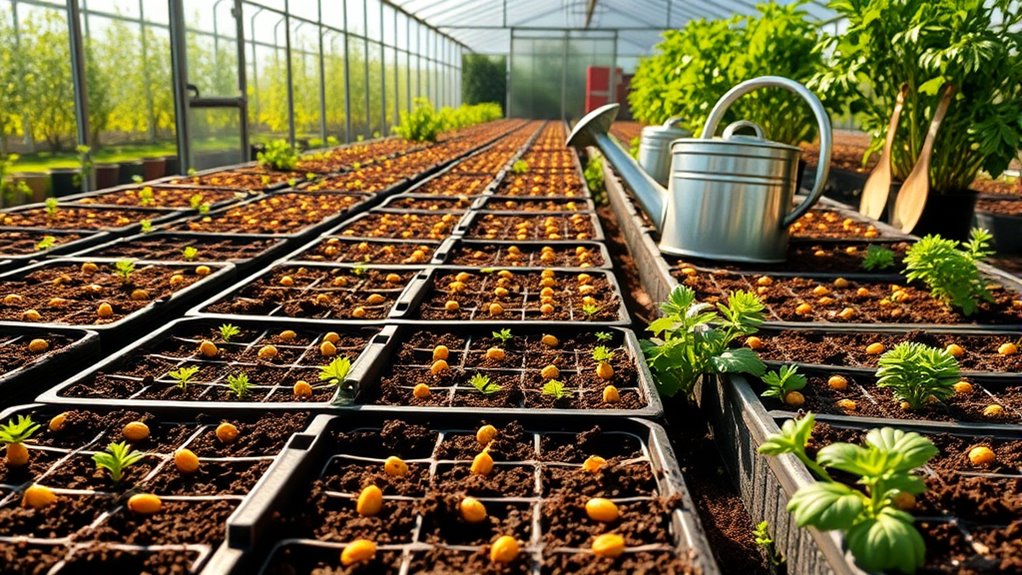
To ensure a successful carrot harvest, it’s essential to sow your seeds under optimal conditions.
Start by preparing well-drained, sandy soil, free from large stones that might hinder root growth. Aim for daytime temperatures around 75°F and nighttime temperatures near 55°F. Sow your seeds about ½ inch deep, spacing them ½ inch apart.
Prepare well-drained sandy soil, maintain optimal temperatures, and sow seeds ½ inch deep for a successful carrot harvest.
After germination, thin them out to 1-4 inches apart as they grow. Make sure your carrots receive full sun for 6-8 hours daily, and keep the soil consistently moist but not soggy to prevent seed rot.
Remember, seeds typically germinate within 7-21 days, so monitor their progress closely to ensure a bountiful crop.
Happy planting!
Caring for Carrot Plants in a Greenhouse
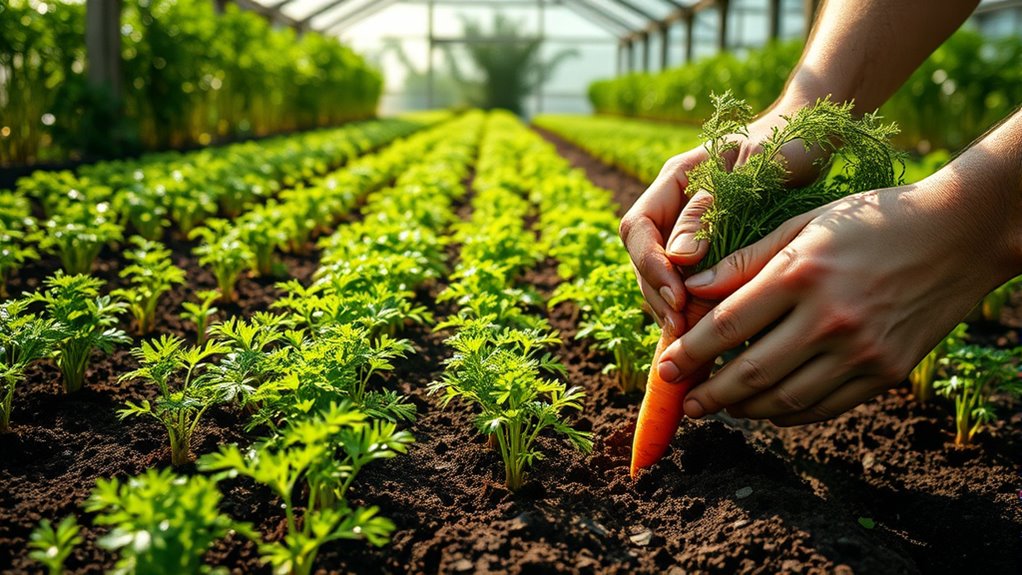
While caring for carrot plants in a greenhouse, it’s crucial to maintain optimal environmental conditions to ensure healthy growth.
Start with well-drained, fertile soil that has a pH between 6.0 and 6.8. Incorporate organic matter like compost and remove any large stones to promote root development.
Keep the soil consistently moist but not soggy; aim for at least one inch of water weekly. Consider using drip irrigation and mulch to retain moisture.
Fertilize with a general fertilizer every 3 to 4 weeks, avoiding high nitrogen and manure.
Regularly inspect for pests like leafhoppers and implement integrated pest management strategies.
Maintain temperatures between 55°F and 65°F, ensuring your carrots receive at least six hours of sunlight daily.
Harvesting Carrots at the Right Time
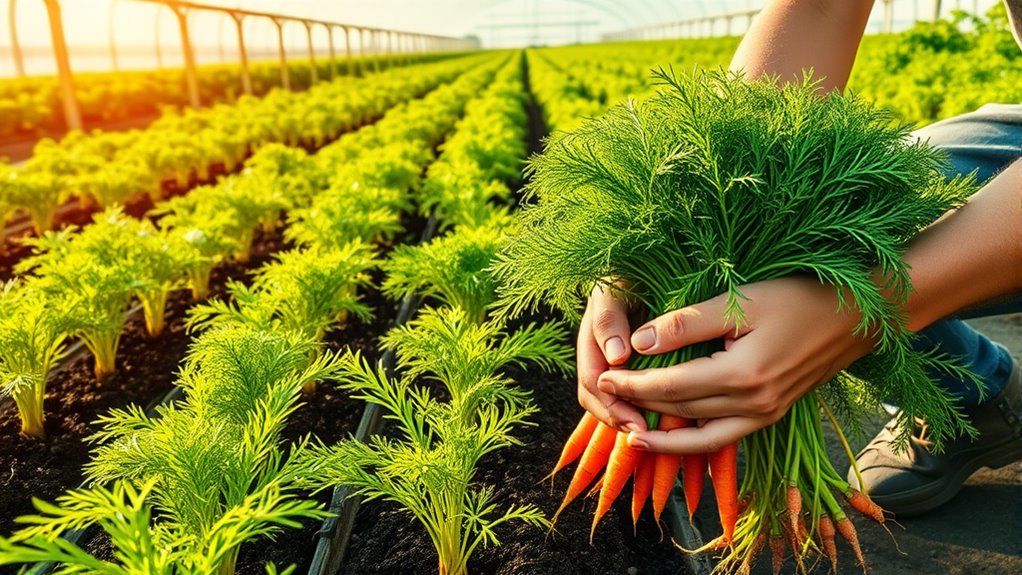
After providing the right care for your carrot plants, knowing when to harvest them is key to enjoying their full flavor and texture.
Look for carrots that have reached a diameter of about 1/2 to 3/4 inches and display a consistent color, whether orange, purple, yellow, or white.
Check their firmness by gently pulling aside the soil. When the foliage appears slightly wilted, it’s often a sign that they’re ready.
To harvest, loosen the soil first, then use a fork or trowel to lift them out without damaging the roots.
Remember to trim the tops to about an inch above the root after harvesting.
Timing is crucial—harvest when they’re mature but not too late to avoid woodiness.
Tips for Continuous Carrot Harvesting

Continuous carrot harvesting can be achieved with careful planning and regular maintenance.
Start by preparing well-draining, loose soil that’s at least 12 inches deep. Maintain consistent soil moisture and consider applying a general fertilizer one week before sowing.
Prepare loose, well-draining soil and maintain moisture for optimal carrot growth before sowing.
Implement a staggered planting schedule, choosing varieties with different maturity times to ensure a steady supply. Maximize space by planting in waves and adjust temperature and lighting to extend the growing season.
Regularly monitor soil moisture and use efficient irrigation systems to prevent overwatering. Keep your greenhouse clean to reduce pests and diseases, and ensure good ventilation to promote air circulation.
With these strategies, you’ll enjoy fresh carrots throughout the growing season.
Frequently Asked Questions
Can I Grow Carrots Year-Round in a Greenhouse?
Yes, you can grow carrots year-round in a greenhouse!
To succeed, keep the temperature between 55-65°F, ensure well-drained soil, and provide at least 6 hours of direct sunlight daily.
Water consistently, but avoid waterlogging.
To maintain a continuous supply, sow seeds at intervals and choose a mix of varieties.
Monitor for pests and diseases, and rotate your crops annually to keep your soil healthy.
With proper care, you’ll enjoy fresh carrots all year!
What Temperature Should I Maintain in the Greenhouse for Carrots?
To create a cozy haven for your carrots, you’ll want to keep the temperature between 55°F and 65°F. It’s like giving them a warm hug!
For germination, aim for 40°F to 86°F, ensuring they feel just right. During the day, let the temperature rise to around 75°F, but don’t forget to let them cool off at night to about 55°F.
This balance will help your carrots thrive beautifully!
How Can I Prevent Pests in a Greenhouse Environment?
To prevent pests in your greenhouse, start by installing insect screens that keep unwanted visitors out while allowing airflow.
Maintain a vegetation-free zone around the greenhouse to minimize pest habitats.
Regularly clean your space to eliminate debris and weeds.
Introduce beneficial insects, like ladybugs, to control pest populations naturally.
Lastly, monitor your plants regularly for early signs of trouble, using integrated pest management techniques for the best results.
Is Natural Sunlight Sufficient for Greenhouse Carrot Growth?
Natural sunlight can be sufficient for growing carrots, but it depends on several factors.
You need to ensure your greenhouse provides 6-8 hours of direct sunlight daily. You should also monitor temperature fluctuations, as too much heat can stress the plants.
Consider shading during peak sun hours to prevent overheating. If sunlight’s inconsistent, you might need to supplement with grow lights to maintain optimal growth conditions throughout the year.
Can I Interplant Carrots With Other Vegetables in the Greenhouse?
Yes, you can interplant carrots with other vegetables in your greenhouse! Doing so maximizes space and can help with pest control.
Just be mindful of the plants you choose; for example, onions and radishes work well as companions because they deter pests and utilize space effectively.
Avoid deep-rooted plants like potatoes that compete for nutrients.
With careful planning, you’ll enjoy a diverse and bountiful harvest from your greenhouse!
Conclusion
Growing carrots in a greenhouse can be incredibly rewarding if you follow the right steps. Remember, “patience is a virtue”—it takes time for those seeds to sprout and develop into delicious carrots. By creating the ideal environment, preparing your soil properly, and caring for your plants, you’ll set yourself up for a bountiful harvest. With a little dedication and attention, you can enjoy fresh carrots all season long! Happy gardening!
